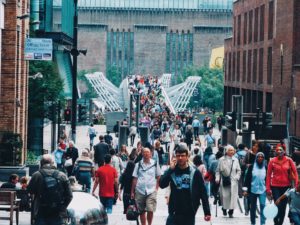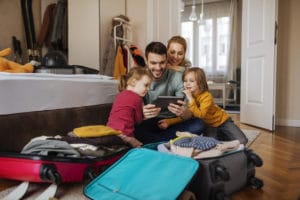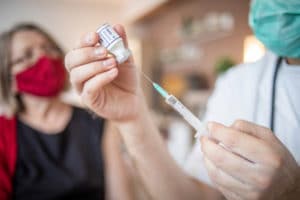Viruses are parasites. In fact, they are inert outside of a host, biding their time until they encounter a suitable cell to latch onto.
But while viral infection can be viewed as a parasitic relationship, there’s a symbiotic relationship at work too, between the way that airborne viruses spread and the way that humans move.
Viruses such as COVID-19 and its variants are opportunistic, taking to the air to spread and reproduce. But these aerosolized particles have a limited lease on life – COVID-19 virions typically last less than three hours in the air.
Unfortunately, as humans, we play right into COVID-19’s hands. The way that we live (often in high-density cities, and gathering for work, school, and play) and the way that we move (freely, frequently, and blind to infection risk) facilitates viral contagion.
What can we learn by comparing what we know about viral transmission vis-à-vis what’s known about human movement? Spoiler alert: It points to a movement-based risk assessment tool like Roamwell.
Afloat, with an expiration date
Viruses are everywhere.
In fact, viruses are the most prevalent form of life on the planet. (Whether viruses are alive, since they can’t function outside of a host cell, is a point of contention.) Molecular scientists estimate that we coexist with some 10,000,000,000,000,000,000,000,000,000,000 viral particles globally. Many are benign; some are lethal.
On its own – that is, outside of a host cell – a virus shields its DNA or RNA genome with a protein shell, or capsid. Certain viruses such as COVID-19 further protect themselves with an outer lipid envelope. (This fatty envelope can be broken down by soap, which is why hand-washing is an effective precaution against COVID-19.)
Always on the lookout for a new host cell, many viruses – again, like COVID-19 – take to the air. They can hitch a ride on a gentle gust of air, or surf the wave of air expelled when an infected person talks, coughs, or sneezes. In the case of COVID-19, these aerosolized particles have a limited trajectory (usually about six feet), and a limited lifespan (three hours or less), unless they are recirculated in a poorly ventilated area.
That means COVID-19 is at the mercy of us, as humans. Unless the viral particles can find a new host within the right distance, within the right time frame, they’re doomed.
Sad to say, we keep giving COVID-19 a way to leapfrog forward. How humans congregate and move continues to put us at risk.
On the move, blind to risk
Let’s take a trip back in time. We’ll set our time machine for the recent past, say October of 2019, right at two years ago.
Let’s further imagine that we can assess our nation from a bird’s-eye view. What can we observe about human interaction and movement in our country, absent the social distancing guidelines and lockdowns in the two years since?
• We are a nation of cities. A full 83% of Americans live in urban areas. More than 300 of the nation’s urban areas have populations topping 100,000. The average population density in cities is 283 people per square mile, but some urban areas are far more dense: New York City averages more than 27,000 people per square mile.
• We are social creatures. This is true of humans, not just Americans. Owing to an evolutionary predisposition toward cooperation as means of survival, we gather for work, school, play, and worship. People from different households, each with their own microbiome (personal sphere of microorganisms, including viruses) often interact with one another in person.
• We are touchy. We hug each other in greeting. We seal business deals with a handshake. We step closer to a friend when we can’t hear what she’s saying. Our school-age children play tag at recess, while our teenagers hold hands watching a basketball game, where players collide vying for a loose ball. Human contact and proximity pervades our interpersonal interactions.
What’s the takeaway?
Left to our own devices, we live, gather, and interact in just the way that an airborne virus like COVID-19 needs us to so that it can spread. Unfortunately, our innate need to associate and cooperate dovetails with the biological mechanism that viruses have evolved to replicate.
Worse, we move about without a keen awareness of the risk to ourselves, or others.
Small wonder that human mobility is recognized as a driver of infectious agents. Studies with Ebola pointed to patterns of contact influenced by transportation, growing seasons, and religious gatherings. And researchers from Northwestern and Stanford were able to accurately predict the spread of COVID-19 in 10 major cities by analyzing three movement-related factors that drive infection risk: where people go, how long they linger, and how many other people are visiting the same place at the same time.
Those researchers and others benefited from recent breakthroughs in approximating human movement, including anonymized cell phone data to illuminate footfall traffic. Google, for its part, publishes community mobility data, using aggregated data to illustrate movement patterns.
At the same time, AI and machine learning have emerged to synthesize the vast amount of data available. The computational power required is now at hand.
A smart movement solution
Viruses aren’t going to change the way that they move. But we can change how we move, by making informed decisions.
Roamwell from Pandemic Insights is the world’s first smart movement solution. Roamwell uses proprietary AI and machine learning to glean actionable insights from trusted data pools. These exposure risk assessments are hyperlocal – not county by county, but street by street, and building by building.
In this way, Roamwell paves the way for smarter mobility, helping to manage the risk for COVID-19 and other airborne pathogens. As a free mobile app, Roamwell will equip everyone, everywhere, with the insights they need to assess their personal exposure risk, as well as the exposure risk associated with the places they go. Roamwell Business will help business executives and managers make smarter “Future of Work” decisions about facility, manufacturing, and supply chain routing, informing the remote vs. in-person workforce choices.
Later – in 2022 and early 2023 – other Roamwell applications will help policymakers to facilitate greater mobility and avoid lockdowns. And as an Internet of Things API resource, Roamwell will let app developers augment their travel, transportation, and ride-share apps with real-time risk indexes.
The answer is found in the question
If we ask ourselves how best to address COVID-19 contagion (or that of its variants, or even some future, unknown pathogen), we can start by understanding how airborne viruses spread – how they move.
It becomes clear that a movement-centric problem requires a mobility-based solution.
With Roamwell, no longer will millions of people be “flying blind” as they make crucial movement decisions that could put them, or those they love, in harm’s way. Instead, a simple glance at their phone will help them assess their own personal exposure risk, and make smarter decisions about how, when, and where to go.
Roamwell is the right solution for right now, when millions globally remain unvaccinated for COVID-19, including many children under the age of 12. Roamwell helps individuals manage exposure risk for themselves and for those around them – including the unvaccinated, the immunocompromised, and those in high-risk groups, such as the elderly.
If we want to outsmart viruses, we have to start by moving smarter. That starts with Roamwell.


